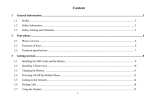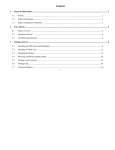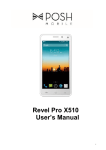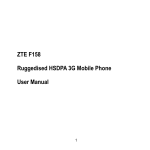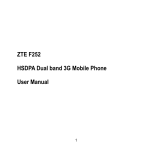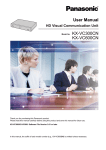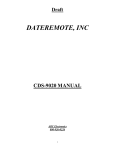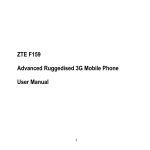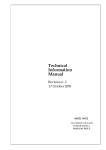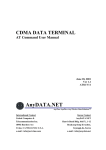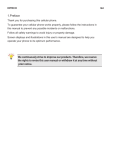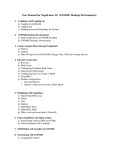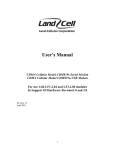Download WP805 User Manual.p65
Transcript
WP805 CDMA Wireless Fixed Phone User Manual 1 Sharing New Technology With You ZTE CORPORATION Sharing New Technology With You Copyright © 2005 by ZTE Corporation All rights reserved. No part of this publication may be excerpted, reproduced, translated or utilized in any form or by any means, electronic or mechanical, including photocopying and microfilm, without the prior written permission of ZTE Corporation. Edition: 1st edition, Jan., 2005 2 1 General Information ........................................................ 6 1.1 Preface ......................................................................................... 6 1.2 Safety Precautions ....................................................................... 6 1.3 Cleaning and Maintenance ........................................................... 6 2 Getting Started ............................................................... 8 2.1 Checking the Package ................................................................. 8 2.2 Technical Specifications ............................................................... 8 2.3 Key Definition ............................................................................... 9 2.4 Display Icons .............................................................................. 10 2.5 Installation .................................................................................. 10 2.6 Power supply .............................................................................. 12 2.7 Connecting to the Network ......................................................... 13 3 Basic Operations .......................................................... 14 3.1Making a Call ............................................................................... 14 3.1.1 Making a Domestic Call ................................................... 14 3.1.2 Dialing PSTN’s Extensions .............................................. 14 3.1.3 Making IDD ...................................................................... 14 3.1.4 Dialing a Number in the List ............................................ 15 3.2 Answering the Call ...................................................................... 15 3.3 Ending the call ............................................................................ 15 3.4 Redialing ..................................................................................... 16 3.5 Billing Information ....................................................................... 16 3.6 Call Menu ................................................................................... 16 3.7 Making a Three-way Call ............................................................ 16 4 Function Menu .............................................................. 18 4.1 Usage of the Function Menu ...................................................... 18 4.2 Structure of the Function Menu .................................................. 18 4.3 NAMES ....................................................................................... 21 4.3.1 Searching ......................................................................... 22 4.3.2 Adding New Name ........................................................... 22 4.3.3 Editing Names ................................................................. 23 3 Sharing New Technology With You Contents Sharing New Technology With You 4.3.4 Deleting Names ............................................................... 4.3.5 Checking Used Space ..................................................... 4.3.6 Sorting Name Cards ........................................................ 4.3.7 Sending Messages .......................................................... 4.3.8 Add to speed .................................................................... 4.3.9 Sending Name Card ........................................................ 4.3.10 Setting the Default Number ........................................... 4.4 Messages ................................................................................... 4.4.1 New Messages ................................................................ 4.4.2 Writing Messages ............................................................ 4.4.3 Viewing Received and Saved Messages ........................ 4.4.4 Msg setting ....................................................................... 4.5 Calls ............................................................................................ 4.5.1 Viewing Calls List ............................................................. 4.5.2 Clear Logs ........................................................................ 4.6 Profile .......................................................................................... 4.6.1 Selected Profile ................................................................ 4.6.2 Edit Profile ....................................................................... 4.7 Organizer .................................................................................... 4.7.1 Alarm Clock ...................................................................... 4.7.2 Calculator ......................................................................... 4.7.3 Personal Finance ............................................................. 4.7.4 Notepad ........................................................................... 4.7.5 Schedule .......................................................................... 4.7.6 World Clock ...................................................................... 4.8 Diverts ......................................................................................... 4.9 Settings ....................................................................................... 4.9.1 Phone Settings ................................................................ 4.9.2 Display Settings ............................................................... 4.9.3 Call Setting ...................................................................... 4.9.4 Security Setting ................................................................ 4.9.5 Reset Settings ................................................................. 4.9.6 Manager Set .................................................................... 4 23 23 23 24 24 24 24 24 25 25 25 26 27 27 27 28 28 28 28 29 30 31 34 36 38 39 40 40 40 40 41 42 42 5 Sharing New Technology With You 5 Text Input ...................................................................... 43 5.1 Overview ..................................................................................... 43 5.2 Keyboard Definition .................................................................... 43 5.3 Notes on Input Methods ............................................................. 43 5.3.1 English and Number Input ............................................... 43 5.3.2 Entering Set Idioms ......................................................... 44 6 Data Network Access Function ................................... 45 6.1 WIN98 Configuration for Internet Access ................................... 45 6.2 WIN2000 Configuration for Internet Access ............................... 49 6.3 WIN XP Configuration for Internet Access ................................. 54 6.4 Usage of the USB-serial cable ................................................... 61 7 Fax ................................................................................. 62 7.1 Summary .................................................................................... 62 7.2 Installation .................................................................................. 62 7.2.1 System Requirement ....................................................... 62 7.2.2 Set the WP805 phone ...................................................... 62 7.2.3 WINFAX Installation ......................................................... 74 7.3 How to use WINFAX ................................................................... 76 7.4 Notice .......................................................................................... 81 8 Troubleshooting ............................................................. 83 1 General Information 1.1 Preface Sharing New Technology With You Thank you for using WP805 CDMA wireless fixed phone. To guarantee your phone always in its best condition, please read this manual carefully. Besides its basic call function, the WP805 provides many practical functions including telephone number grouping, clock and calculator, which bring great convenience and fun to your work and daily life. With its rich functions applied in business, the WP805 phone will be your right-hand assistant. 1.2 Safety Precautions Keep the phone from water or damp areas. Water or other liquid will cause overheating, electrical leakage and failure of the phone. Do not disassemble the phone by yourself. Put the phone in a safe and stable place. Do not touch the antenna while calling. Keep the phone from heat radiation and dust. Unplug the external power adapter or take out the battery before you put the phone out of use for a long period of time. Use the external power adapter approved by the phone manufacturer. Do not unplug the connector of the serial port cable from the phone when the power is on. Try to use the phone at least 20 cm away from ordinary fixed telephone, TV sets, radio and other automated office equipment so as to avoid electromagnetic interference. Keep the phone away from explosive or inflammable articles. 1.3 Cleaning and Maintenance The phone is not water-resistant, so do not use it in high humidity places such as the bathroom. 6 General Information 1 Sharing New Technology With You Wipe and clean the phone with soft and dry cloth. Do not wipe the phone with the solution of alcohol, dilution agent or benzene, etc. Use the phone within a temperature range of -10°C~55°C and a humidity range of 25%~85%. 7 2 Getting Started 2.1 Checking the Package Please check all the parts shown below and make sure no piece is missing or broken. ( The appearance of the parts in your package may be different from those in the manual.) Sharing New Technology With You Main Unit (1) Handset (1) Serial port cable (1) Certificate of quality (1) Handset Cord (1) Antenna (1) External power adapter (1) User Manual (1) USB serial cable (1) (optional) USB Driver CD (1) (optional) 2.2 Technical Specifications Air interface protocol: IS-2000SR1, downward compatible with IS-95A/B. Frequency range: Tx: 824~849MHz Rx: 869~894MHz LCD: large dot matrix LCD/outgoing number/ talk time/ clock/CID/ RSSI signal intensity/ battery level/ short message indication External interfaces: a. External power socket (DC) b. DATA interface (DB-9) c. Antenna connector TNC (F) 8 Getting Started 2 Power supply: 100V-240V, 50Hz (AC) Voice decoding: 13K QCELP/ 8K EVRC Dimensions (W×H×D): 180 mm×207 mm×70 mm (1) LCD (2) NAMES/BACK (Right Soft Key): To access the phone book and execute functions as shown in the lower right corner of the LCD. (3) Up/Down/Left/Right key (Scroll keys): To move the cursor when entering letters and to scroll through menu options and displays, can be set as hotkeys. (4) MENU/SELECT (Left Soft Key): To access the main menus and execute functions as shown in the lower left corner of the LCD. (5) 0~9 number keys: To enter numbers and characters. (6) * key and # key: They have different functions in different modes or function menus. Please refer to corresponding sections. (7) CHARGE LED: 9 Sharing New Technology With You 2.3 Key Definition 2 Getting Started It glows red when you charge the battery, and turns green when the battery is fully charged. Sharing New Technology With You (8) key: Switch on/off the phone; hang up; display calendar in the standby mode, return to the idle state from menu. (9) CLR key: Lets you clear your last entry. (10) CALL/REDIAL key: To make a call or redial the last number called after you pick up the handset or press HANDFREE key. (11) HANDFREE: Hand-free key. Hint: The shape of the key shown in this manual may be different from your phone. In this manual, the expression “press a key-press” stands for pressing a key shortly, while “hold the key-press” for pressing a key for 2~3 seconds. 2.4 Display Icons The icons listed below may appear on your phone’s LCD. Signal indicator. More bars indicates stronger signal. Indicates that you have received a new message. If the icon blinks, it indicates that the message box is full. The Alarm is set. You have set “divert all calls”. Battery level indicator. More black bars indicate higher level. The ring is off. Bar all incoming calls. Bar list or bar all except list. 2.5 Installation Back sight of WP805: 10 Getting Started 2 Antenna connector Power switch Data interface External power socket 2. Antenna: Install the antenna to the antenna connector. Hold the plastic stick of the antenna and turn the metal screw clock-wise. Do not turn the antenna directly. 3. Adapter Plug the AC/DC adapter into an appropriate wall outlet. Good grounding may guarantee your terminal in a reliable service status. AC Plug 11 Sharing New Technology With You 1. Handset: Connect the main unit and the handset with the handset cord, plug the cord into the handset socket on the left side of the main unit. 2 Getting Started Sharing New Technology With You 4. Computer Use the serial port cable or USB serial cable for connecting the data interface at the back of the phone with COM1 or COM2 of the computer for data service. Turn off the switch then stick in or pull out serial port line. 5. Power on: beside the external power socket on the back Turn the switch side of the phone to “O”, and then get started after self-test. 6. Power off: Turn the switch to “I”, then pull out the adapter from the socket. 2.6 Power supply There are two ways of power supply: 1. Use the external power adapter. 2. Use the built-in spare battery of the phone. When using the phone, please connect it with the external power adapter. With external power supply, the phone will automatically check electricity quantity of the battery and charge the built-in battery. Use the built-in spare battery of the phone in case of power failure or when there is no available power socket nearby. If the electricity of the built-in battery will be used up, please connect the external power adapter for charging in time. The screen will prompt and the buzzer will beep. Battery status LED: While charging, the LED indicates red. If the battery is full, the LED changes to green color. Battery indicates: Standby time 22 hours + Talk time 2 hours in 12 Getting Started 2 power supply of the built-in spare battery (depending on the network condition). 2.7 Connecting to the Network Now your phone is in the standby mode. Besides receiving and sending calls, you can do the following things: to display the calendar. Press Press Right Soft key to enter the names. Press Left Soft key to enter the function menu. Please refer to Chapter 4. Note: If “EMERGENCY CALLS ONLY” is shown on your screen, you can only send emergency calls relating to the strength of the signal. 13 Sharing New Technology With You When the connection is set, the name of the network service provider will be displayed at the center of the screen. The display will not be the same as below with different service providers. 3 Basic Operations 3.1 Making a Call 3.1.1 Making a Domestic Call Sharing New Technology With You Method: (After you pick up the handset or press HANDFREE key) Area code (when making a long distance call) telephone number CALL/REDIAL key You can clear the last number by press “CLR” key. Call status will be displayed when the network is connected, and there will be a prompt if the put-through tone is set as on. Please refer to paragraph 4.9.3 “Call setting”, get the information of put-through tone. If the call is over, hang up or hook on the receiver, and then press key to return to the idle state. 3.1.2 Dialing PSTN’s Extensions Method 1: (After you pick up the handset or press HANDFREE key) Dial the exchange number and then the extension. Method 2: Add pause character “P” (holding # key to enter “p”) between exchange number and extension number, and then your phone will dial the extension automatically. Area code Exchange number P Extension number CALL/REDIAL key An example of using pause character “P”: 8880000 P 6666 P 8888. After the first part of this number is replied, 6666 will be automatically dialed and the second pause character will generate a delay of 5 seconds before 8888 is sent. (The first P indicates the pending put-through, and the latter P stands for the 5-second delay.) 3.1.3 Making IDD Method: (After you pick up the handset or press HANDFREE key) + Country code Complete telephone number CALL/REDIAL key. Before you make an international distance call, hold the * key until your screen displays the prefix symbol “+” of an international call. 14 Basic Operations 3 After the prefix is inputted, enter the code of the country you want to dial and the complete telephone number. Country codes follow the conventions (Get rid of “0” before the area code when you make a call). For example, +862164008090. Generally, all calls you have made or received are saved in a list of the phone, and the last made or received call is saved at the top of the list (please refer to Section 4.5 “Call Log”. All numbers are grouped as dialed calls, received calls and missed calls. Your phone lists all the numbers so that you can view all the call logs. You can check the list by the following operations: View All calls by CALL/REDIAL key. View Received calls by Down key. View Missed calls by Up key. All the numbers in the list can be directly dialed by press HANDFREE key CALL/REDIAL key OK Left Soft key. When there is a list of phone numbers, you can press Select key to view the details and then Save key to save the number to the phonebook; SMS key to send messages to the number, key to exit. Note: Up/Down key can be customized in Phone settings--Fast key Setting. 3.2 Answering the Call When the phone rings, LCD will display the incoming number. Pick up the receiver to answer the call, and timing will start for the call. Note: To display the incoming number requires the network to support. 3.3 Ending the call Put down the handset when you answer the call by picking up the handset. Press HANDFREE key when you answer the call by pressing HANDFREE key. 15 Sharing New Technology With You 3.1.4 Dialing a Number in the List 3 Basic Operations Press key to return to the original state after ending call. 3.4 Redialing Press CALL/REDIAL key to redial the last number called after you pick up the handset or press HANDFREE key. Sharing New Technology With You 3.5 Billing Information The phone adopts pulse-charging mode and the charging unit is “unit”. When the call is over, the billing information will displayed. For example, the message means: when a call is connected, 2unit will be displayed; since then, 2units will be added per 10 seconds. If you dial a free number, the phone will display 0unit. For example, if call duration is 15 seconds, 4units will be displayed. If call duration is 20 seconds, 6units will be displayed. Note: This function requires the network to support. 3.6 Call Menu In put-through mode, you can enter the call menu by pressing Menu. The operation methods are the same as those in the function menu; please refer to Section 4.1 “Usage of Function Menu”. You can do the following operations in Call menu: Hold /Retrieve Keep the current session or resume the held call. Mute Not send local voice. DTMF off/on Enable or disable sending DTMF tone. Menu Enter the organizer menu. Note: This Call menu only appears in the session process, which supports Three-way Call. 3.7 Making a Three-way Call The phone supports the Three-way call. When two parties are talking, 16 one of which can dial the number of the third party without hanging up the current session. When the session is ongoing, the receiver/caller enters the number of a third party and the current call will not be affected. If the receiver/caller presses CALL/REDIAL key at this moment, the current session will be hung on, and the receiver/caller will not hear the former call temporarily. Press CALL/REDIAL key again and the call will resume. The user can hear the ring-back tone from the third party before he answers. When the third party answers, the three persons can talk at the same time. If the user presses CALL/REDIAL key, the third party will be hung up and it becomes an ordinary call between two persons again. Note: The network service provider should support the Three-way call function. When the calls are switched, the hung-on party should not hang up or it will stop the original two-way call. 17 3 Sharing New Technology With You Basic Operations 4 Function Menu Sharing New Technology With You 4.1 Usage of the Function Menu 1. Basic operation In original state, press MENU/SELECT key to enter function main menu. Press Up/Down key to select menu item. Enter the next menu item by press Select key, Go back to previous menu by press Back soft key . In this manual, press Menu Calls, means press MENU/SELECT key and then select Calls options. 2. Scrolling function: Enter the function main menu by pressing Left Soft Key in the standby mode. Enter the call menu interface by pressing Left Soft Key in the session mode, and use Up/Down key to scroll and select. 3. Shortcuts select function: If Menu Code is set as on, its shortcut number will be shown in the upper right corner of the screen. Press Menu in the standby mode and enter the shortcut number in the function options. (Note: some menus may have no such shortcut select function.) 4. Quit the menu: In most conditions you can press Right Soft key to quit a certain menu or press key to return. 4.2 Structure of the Function Menu The default structure of the Function menu is as follows: 1 Messages 1-1 Create Msg 1-2 Received Msg 1-3 Sent Msg 1-4 Msg Settings 1-4-1 Status Rept 1-4-2 Callback No. 1-4-3 Set idiom 1-4-4 Set poem 1-4-5 Priority 18 1-4-6 Msg Period 2 Calls 2-1 All calls 2-2 Missed calls 2-3 Received calls 2-4 Dialed calls 2-5 Clear logs 2-6 Last call 2-6-1 Time 2-6-2 Cost 2-7 All call info 2-7-1 Time 2-7-2 Cost 2-7-3 Clear logs 3 Profile 3-1 Selected Profile 3-2 Edit Profile 3-2-1 Normal 3-2-1-1 Ringtone type 3-2-1-2 Ringtone Vol 3-2-1-3 Speaker Vol 3-2-1-4 Key tones 3-2-1-5 Warn tone 3-2-1-6 Message alert 3-2-2 Outdoor (sub menu same as 3-2-1) 3-2-3 Silent (sub menu same as 3-2-1) 4 Organizer 4-1 Alarm clock 4-1-1 Set alarm 4-1-2 List alarms 4-1-3 Define restday 4-1-4 Clear all 4-2 Calculator 19 4 Sharing New Technology With You Function Menu Sharing New Technology With You 4 Function Menu 4-3 Personal finance 4-4 Notepad 4-5 Schedule 4-6 World clock 5 Diverts 5-1 All Calls 5-1-1 On 5-1-2 Off 5-1-3 By service 5-2 When busy (sub menu same as 5-1) 5-3 No answer (sub menu same as 5-1) 5-4 When hide (sub menu same as 5-1) 6 Settings 6-1 Phone Settings 6-1-1 Menu code 6-1-2 Fastkey Setting 6-2 Display Settings 6-2-1 Backlight 6-2-2 Owner name 6-2-3 Greetings 6-3 Call Settings 6-3-1 Minutemind 6-3-2 Conn mind 6-3-3 Network number 6-3-4 IP Setting 6-3-4-1 Status 6-3-4-2 Number 6-3-5 DDD settings 6-3-5-1 Status 6-3-5-2 Number 6-4 Security 6-4-1 SMS password 6-4-1-1 SMS 20 Function Menu 4 6-4-2 Handset lock 6-4-2-1 Password 6-4-3 Handset call bar 6-4-3-1 Bar Incoming 6-4-3-2 Bar Outgoing 6-5 Reset settings 6-6 Manager set 6-6-1 Hide IP 6-6-2 Clean admin data Enter the NAMES in the standby mode by pressing Right Soft key. It shows List empty when there is no record in the NAMES, and you can add records by pressing Left Soft key. Saved records will be listed in the record list. The records will be listed in alphabetical order of initials of the names. View records by pressing Up/Down key. In this screen quick-search can be done by entering letters, and the letters you enter can be shown in the upper right corner. For example, if you want to search the name “JASON”, you can enter “J”, then the cursor will move to the names that begin with “J”. If there is no such record in the NAMES, it will stop at the most appropriate record. Press Left/Right key to switch between groups, and all records can be seen in the default status. You can view details of the NAMES by pressing View. 21 Sharing New Technology With You 4.3 NAMES Sharing New Technology With You 4 Function Menu One name can match three numbers and one E-mail address when saved in the phone. Numbers can be any of the following five types: Mobile, Home, Office, Fax, Pager Shown in the upper right corner are the serial numbers of the Names. - Press Menu to enter the detailed menu of Names. - Press CALL/REDIAL key after you pick up the handset and you can dial the first of the numbers corresponding to the current name. key to return to the list interface. - Press If the number is longer than one line, there will be an arrow at the bottom of the screen. Press Left/Right key to view the whole number. 4.3.1 Searching 1. Press Names, enter name menu. 2. Press Menu Search, enter the name or first letter of name you want to search, and then press OK. Or Enter the serial number of the phone numbers you want to search directly in home screen. For example: Enter “25#”, the phone number saved in the 25th place will be displayed. 4.3.2 Adding New Name Press Names Menu Add new name. If it is in the status of viewing all records, you can save the new name into the phone memory. To save the name to the phone, as shown in the following figure, the user can choose the input options. But the user must enter at least the name and one phone number. After entering the name, choose the group; and after entering the phone number, choose the number type. Press Save to save the changes or key to abort the changes. 22 Function Menu 4 Note: Please refer to Chapter 5 for text input. Press Names, select one name, press Menu to choose Edit and then edit the present names including the name, the phone number and the group. 4.3.4 Deleting Names 1. Press Names, select one name. Delete, delete the present selected Name. 2. Press Menu 3. Press View Menu Delete number to delete the present number. 4.3.5 Checking Used Space Press Names Menu Used Space, and you can view the total number of saved entries and the maximum number of entries to be saved in the phone. 4.3.6 Sorting Name Cards Name cards are sorted as follow: Family, Friends, Colleague, Schoolmate, Society, VIP. The Name cards unsorted by the user are grouped as Unsorted Records. After you enter Names menu, you can: Switch between groups: Press Left/Right key. Set ringing tones to distinguish calls from different groups: Press Menu Group Setting Tone, choose the ring tone. Rename the group: Press Menu Group Setting Rename. Exit the current menu, press key. 23 Sharing New Technology With You 4.3.3 Editing Names 4 Function Menu Move the record to other groups (except “all records group”): select one record from one group(except “all group”), press Menu Add to group. 4.3.7 Sending Messages Sharing New Technology With You After entering the Names screen, select one name, there are two methods to send messages: 1. Press Menu Send message, the message will be sent to the default number (the first number) matching the name. 2. Press View, select one number of the name, Press Menu Send message, messages can be sent to the selected number. 4.3.8 Add to speed Press Names, select one from the list , then press View and Menu in turn, then select Add to speed to append the current number into speed number list. In the standby mode, one can hold the serial number of the current number for 2~3 seconds to make a call directly. Numbers can be deleted by pressing the Delete right soft key in this list. 4.3.9 Sending Name Card Press Names View Menu, select Send name card, the current Name card (excluding E-mail address) will be sent out as a message. If you select Send to one, you can enter the number or choose the number from names. If you select Send to many, you can only choose the number from names. 4.3.10 Setting the Default Number The first of the numbers matching each name is set as a default number. You can change it. Press names View, select one number, then press Menu Set as default , the current number can be assigned to a name as the first number. 4.4 Messages Your phone can save 40 short messages. The maximum length of each 24 Function Menu 4 message will be 160 characters in English. When receiving a new message, your phone will give an alert tone (if the Sound is set as on). The new message icon will appear on the screen. If not immediately read, the message will be saved to the phone automatically. If the memory is full, a flashing message icon will appear at the top of the screen, prompting you to delete old messages as soon as possible. To read new messages, select Menu messages Received Msg. 4.4.2 Writing Messages Select Menu messages Create Message, enter message texts. Press OK and scroll to Send to one or Send to many. - When choosing Send to One, you can press Number keys to enter the phone number or use Right Soft key to choose the number from the Names. - When choosing Send to many, your phone will automatically navigate to the name list; you can only choose one name from the list and continue to choose other names after confirming. If Set Callback No. option is set ON in the Msg Settings item of Messages Menu, after you enter the destination number, press OK, the phone will prompt you to enter the call-back number, and then press OK again to send the message. 4.4.3 Viewing Received and Saved Messages Select Menu messages Received Msg to view received messages. Select Sent Msg to view those messages saved but not sent . 25 Sharing New Technology With You 4.4.1 New Messages Sharing New Technology With You 4 Function Menu In the message list, choose Read to view the message. At this time press Options to do the following operations: - Edit: Edit current message - Delete: Delete current message - Voice Call: Call back by voice - Extract Nos: Extract numbers from the text of the current message and display them in a list. Choosing one number will bring you to the dialing window. The Voice Call option will not appear when you read messages from Sent Msg, and Send option will not appear when you read messages from Received Msg. Delete all: Delete all the received and saved messages. If a name card message is received, a prompt message will appear after choosing Read. You can save the name card message to the phone book after confirmation. 4.4.4 Msg setting You have to make necessary settings before using SMS service. Select Menu messages Message Settings. Status Rept: If the Status Rept option is enabled, when the message reaches the SMS center, the SMS center will inform you in the form of a Status Report message. Note: This function needs the network to support. Callback No.: This submenu is used to set whether to enter the callback number when sending a message. Callback number is the number you want the message receiver to reply to. If you set the callback number, the receiver will see this number in the end of the message. Note: This function needs the recipient’s phone to support callback number identification. Set Idiom: When editing a message, Set Idiom screen can be brought out by double pressing * key. In this screen, phrases can be edited, changed or directly sent out. 26 Function Menu 4 Set Poems: You can save up to 10 poems in your phone and bring out the poems by triple pressing * key while editing the short message. In this menu, poems can be edited, changed or directly sent out. Priority: Press Change to set the priority of sending messages. There are three options: Norm, Inte, or Urge. Msg Period: During Msg Period, SMS center will repeatedly send the short message until it is received. Press Change to set the Msg Period as: 1 day,1 week, or 1month. 4.5 Calls 4.5.1 Viewing Calls List Your phone saves the latest 20 missed calls, 10 received calls and 10 dialed calls, and you can view all of them from the menu. Press Menu Calls to enter. Choose All Calls to view the list of all calls. Choose Missed Calls to view the list of missed calls. Choose Received Calls to view the list of received calls. Choose Dialed Calls to view the list of dialed calls. In the calls list screen: - Press Select to view the detail of this call. - Press Select SMS to send a message to this number - Press CALL/REDIAL key to dial this number directly after you pick up the handset or press HANDFREE key. Last call: Enter Last call submenu, choose Time to view the last call duration and choose Cost to view the last call charge. All call info: Your phone allows you to view the accumulated call duration and accumulated call charge. 4.5.2 Clear Logs Select Menu Calls press Cancel to exit. Clear Logs, press OK to clear all logs, or 27 Sharing New Technology With You Note: This function needs the network to support. 4 Function Menu 4.6 Profile You can choose different profiles in different occasions, or you can customize the profiles according to your own needs. 4.6.1 Selected Profile Press Menu Profile Select profile, then press Change to change the current profile. There are 3 options: Normal, Outdoor and Silent. These options have been preset by the manufacturer. Sharing New Technology With You 4.6.2 Edit Profile In the 3 profiles mentioned above, the following items can be set, select Menu Profile Edit profile, select one profile. Ringtone Type: 20 tones available. Ringtone Vol: The volume of ringer. Press up/ down or left/ right key to adjust. Speaker Vol: The volume of the receiver. Press up/ down or left/ right key to adjust. Key Tones: Press change left soft key to change the volume of the key tone to Low or High. Warn Tone: Enable or disable the warning tone. Message Alert: Set Alert Tone types when receiving new messages. 4.7 Organizer Press Menu vide 6 functions: Organizer to enter organizer menu. The phone pro- 1.Alarm Clock: Providing power-off/ordinary alarm clock service. 2.Calculator: Simple operations such as sum, subtraction, multiplication and division. 28 Function Menu 4 3. Personal Finance: - Small account book: Recording lots of accounts for the user to consult and make statistics. 4. Notepad: Recording lots of necessary data. 5. Schedule: For planning journeys or errands. 6. World Clock: Keeping track of local and world time. Your phone can have a maximum of 5 alarm clocks (excluding the Schedule alarm clock). 1. Set alarm: Press Menu Organizer Alarm Clock Set alarm, and set the following options according to the instructions below: Type: The clock can be set as Single alarm, Daily alarm, Weekly alarm, and Workday alarm according to your preference. Date: It is set as the current day by default. This setting is not necessary if Daily alarm or Workday alarm is set. Time: If Normal is set, the clock Date/Time must be set later than the current date/time, or you will be informed of an invalid date/ time entry. Clock Message: Setting the text message that appears on the idle screen when the alarm sounds. Default is void. Automatic Power-Off/Normal: Press select left soft key and then select one from two options: Automatic Power-off When alarm time arrives, power off the phone automatically without ringing. Normal: Ringing normally when the alarm time arrives. Ring Tone: Setting the alarm clock ringing tone. Press OK to save alarm clock settings when completed. Or you can press “exit” right soft key or key to exit after setting part of the items and the phone will prompt you to save. If you choose to save your settings, the rest items will use default values. If you are informed of invalid 29 Sharing New Technology With You 4.7.1 Alarm Clock 4 Function Menu Sharing New Technology With You alarm clock setting, press Exit to exit setting of the alarm clock. If the alarm clock is properly set, a small corresponding icon will appear on the screen in the standby mode. When Alarm time is coming, your phone will ring and the icon will display. 2.View List Alarms: Select List Alarms, use Up/Down Key to view the set alarm clocks, press Select to enter the setting screen, then press View/Edit to view and edit settings of the alarm clock, press Delete to delete the settings, or press Disable to disable the alarm clock. 3. Define rest day: Select Define rest day to set or change rest day. 4. Clear All: Select Clear All to clear all alarm clock settings. Note: Scheduled alarm clock setting can only be viewed/edited or deleted in Schedule Menu. 4.7.2 Calculator Select Menu Organizer Calculator. Press 0~9 number keys to enter the numbers to be calculated, and press # key to enter the decimal point. Press left soft key or * key as many times as necessary to switch between +, -, × and ÷. Press CLR key to clear the last entry and results. Press key to exit the Calculator. Press Equal to get results. Note: This calculator is not perfect in precision and may cause rounding errors. The maximum length is 9-digit. When the operational data and results exceed 9 digits, an overflow message will be shown. 30 Function Menu 4 4.7.3 Personal Finance Account Book The account book can restore 30 records of financial accounts, dated from 2000 to 2050 AD. Organizer Personal Finance. Press Menu Access Account Book, and the Account Book View screen will show if there are saved data. Access Account Book, and the Add screen will show if there is no data. 4.7.3.2 Account Book View screen: As shown in the figure, the View screen respectively shows the date, name (at most 5 digits) and sum, with “+” representing saving and “-” representing expenditure. Press Up/Down key to view each account, and press Menu to enter the menu interface. Press Delete to pop up a dialog box, and press OK to return. Press key to exit. 4.7.3.3 Menu screen: There are five options in the Menu screen: Edit, Add, Used Space, Account and Clear all. Press Up/Down key to choose from the options. Press Select to enter the next screen. Press Back to return to the previous screen (Account Book View screen). 31 Sharing New Technology With You 4.7.3.1 Account Book screen: 4 Function Menu Note: If the memory is full, no Add option is available. 1.Edit Choose Edit from the menu to enter the Edit screen. Press Up/Down key to move the cursor, and the cursor will switch between date, name and sum. Press Save to confirm the viewed/ed- Sharing New Technology With You ited contents, and press key to abort the changes. When the cursor is on the date, press Number keys or Calendar to enter the date. Press Left/Right key to move the cursor. If the entered date is improper, Left Soft Key has no definition. When the input cursor is on the name, press Number keys to enter the contents, and press # key to switch between the input methods. Press Left/Right key to move the cursor. Press CLR key to clear the last entry. When the cursor is on the sum, press Number keys to enter numbers. Press # key to enter decimal point, with two digits reserved behind the decimal point. Press * key to switch between “+” and “-”. Press Left/ Right key to move the cursor. Press CLR key to clear the last entry. 2. Add Choose Add from the menu to enter the Add screen. Directly enter the Add screen shown as below if there is no record saved. The start date is the present date. Press Up/Down key to move the cursor up and down, and the cursor will switch between Date, Name and Money. Press Save to confirm adding and change to the Account View screen. Press Exit or key to abort adding, and a prompt box will pop up; press OK to exit Account Book. For entering characters, please refer to operations in Edit. 3. Used Space: Choose Used Space from the menu to show the total available space 32 Function Menu 4 4. Account Account range setting: Choose Account from the menu to enter the account date input screen. Both the start and end dates are the present date. Use Up/down or Left/Right key to move the cursor. Press Number keys to enter the date, and if the entered date is improper (including the case when the start date is later than the end date), Left Soft key has no definition. Press Ok to enter the Statistics View screen. Press Exit or key to abort statistics. Account View: The screen shows the total saved sum of currency, total sum of expenditure, and balance. Press Exit to return. 5. Clear All screen Choose Clear All in the menu to enter Clear All dialog, and press OK to clear all records, or press Cancel to return. 33 Sharing New Technology With You and used space. 4 Function Menu 4.7.4 Notepad It can record up to 30 events with the length of 30 characters, for the user to consult at any time. 4.7.4.1 Notepad screen organizer notepad, press Menu soft key, Press Menu the list screen will appear first if there are events recorded. Enter Notepad, and directly enter the Add screen if there are no events recorded. Sharing New Technology With You 4.7.4.2 List screen The list will only show the first line of record for each event. Press Up/ Down key to choose the event, press Menu to enter the Menu screen, press Delete to pop up a dialog box, and press OK to delete it and return to Notepad. Press key to exit Notepad. 4.7.4.3 Menu screen Press Menu organizer Notepad-Menu screen. notepad Menu to enter the This screen lists four options: Edit, Add, Used Space, and Clear All. Press Up/Down key to choose an option, and press exit. key to Note: If the memory is full, no Add option is available. 1. Edit screen Choose Edit in the notepad menu to enter the screen. Press Up/ 34 Function Menu Down key to view the contents, and press Exit or 4 key to return. and return. Press Exit or key to abort the changes and return. 2. Add screen Choose Add in the notepad menu to enter the Add screen, and directly enter the Add screen if there is no event recorded. Press Number keys to enter contents. Two numbers, respectively representing the entered characters and the total characters that can be entered, will show right at the upper part of the screen. Press # key to switch between the input methods. Press Up/Down key to move the cursor, and press CLR key to clear the entered characters. Press Save to confirm the added contents and return. Press Exit to abort adding, and return to the List screen if the Add screen is navigated from it, or exit Notepad if the Add screen is navigated automatically. 3. Used Space: Choose Used Space from the notepad menu to show the total available space and used space. 35 Sharing New Technology With You Press Number keys to enter contents; press # key to switch between the input methods; press Scroll key to move the cursor; and press CLR key to clear entered characters. Press Save to confirm the changes 4 Function Menu 4. Clear All screen Choose Clear All in the menu to enter the prompt screen, press OK to delete all records, or press Cancel to abort deletion and return. 4.7.5 Schedule Sharing New Technology With You The user can schedule 30 entries, dated from 2000 to 2050 AD. 4.7.5.1 Schedule screen organizer Schedule, if scheduled info is Press Menu saved, Schedule View screen will appear. Enter Schedule, and if no scheduled info is saved, Add screen will appear. 4.7.5.2 Schedule View screen View screen will show date, alarm clock tag, start/end time and entry (maximum 2 lines). Start date is the present date. Both start time and end time refer to the time of the present day. The cursor will stop at the date entry. Use Up/Down key to view different entries. Press Menu to view Menu screen, press Delete to pop up the confirmation screen, press OK to confirm and return, or press key to exit Schedule. 4.7.5.3 Menu screen 36 Function Menu 4 Press Menu organizer Schedule Menu. The schedule menu screen lists four options: Edit, Add, Used Space, and Clear all. Press Up/Down key to select an option, and press Back to return to the previous screen. Note: If the memory is full, then no Add option is available. Add to en- Press Up/Down key to move the cursor up and down, and the cursor will switch between date, alarm, start time, end time, and content. Press Save to confirm adding and return to the previous screen. Press Exit or key to abort adding. When the input cursor is on the content, press Number keys to enter contents. Press # key to switch between the input methods. Press Left/Right keys to move the cursor. Press Number keys to enter the date and time. If the entered date and time are improper, move the cursor to the date and time again, and then enter the right value. When the input cursor is on the alarm clock tag, press Menu to enter the Set Alarm screen. Press Set Alarm to set the alarm clock and return, the icon at this time is . Press Menu, then change Set Alarm to Cancel Alarm, the icon at this time is . Press Advanced time to set the time for alarming. 37 Sharing New Technology With You 1. Add screen Press Menu organizer Schedule Menu ter Add screen. The start date is the present date. 4 Function Menu 2. Edit screen Choose Edit in the menu to enter Edit screen. Press Up/Down key to move the cursor, and the cursor will switch between date, alarm, start time, end time and content. Press Sharing New Technology With You Save to confirm the changes and return. Press Exit or key to abort the changes and return. For entering characters, please refer to operations in Add screen. 3. Used Space: Choose Used Space from the notepad menu to show the total available space and used space. 4. Clear All screen Press Clear All in the menu to enter Clear All screen. Press OK to clear all records and exits Schedule. Press CANCEL or key to abort deletion and return. 4.7.6 World Clock 4.7.6.1 Navigation View Select Menu organizer World Clock to enter Navigation screen of World Time. Use Scroll key to select the specific international 38 Function Menu 4 city time. Press NATIVE to enter Native screen. Press Exit to exit World Clock. 4.7.6.2 Native Screen The default item of local city is set as Delhi. Press Up/Down key to select others. Press Exit or key to return to the Navigation screen 4.8 Diverts Call divert service allows you to transfer the incoming call of a specific service to an appointed number. Please contact your network service provider to enable this service. Select Menu Diverts, One can set call transfer to another preset number in different cases: All Calls Transfer all calls. When Busy Transfer when the user’s line is busy. No Answer Transfer when there is no answer. When Hide Including call transfer when there is no answer and the call transfer when line is busy, but with higher priority when transferred to the designated number. After choosing one of the above four options, the followings can be chosen: On Only registered services are functional. Off Delete this transfer service. 39 Sharing New Technology With You of World Time. Press Select to save local city settings and return. 4 Function Menu By Service Set conditions and types of additional services. Choose By Service then Voice calls, Transfer only voice calls. 4.9 Settings Sharing New Technology With You 4.9.1 Phone Settings Press Menu Settings Phone Settings to enter the submenu Phone Settings, you have the following options: Menu Code Choose to enable/disable the function of displaying the menu code. Fastkey Setting Set the shortcut menu contents corresponding to Up/Down/Left/Right key and CLR key in the standby mode. 4.9.2 Display Settings Press Menu Settings Display Settings to choose options as follows: Backlight: Press Change to enable or disable the backlight. Or choose save mode, which disables backlight from 8:00 to 17:00 except at spare time. Owner Name: View or edit the owner’s name and display it below the network name. Greetings: View or edit Greetings at start-up. 4.9.3 Call Setting Press Menu Settings Call Settings to enter Call Settings submenu and you have the following options: Minutemind: Press Change to enter Minute Reminder screen. You can choose to remind you 5S(second) or 15S(second) ahead of every minute when you are talking, or choose Off. Conn mind: If you choose On, you can hear put-through prompt tone while making calls. Network Number (set by operator): Set the number of the network management center. So your phone can run some manager command by professionals. IP Setting (set by operator): If an IP number has been set, IP 40 Function Menu 4 function will be enabled in Phonebook or Call Log, i.e. IP number will be automatically added before the number of the call you are going to make. DDD Setting (set by operator): Set the local area code (including “0”). Note: IP Setting, DDD Setting, and Network Number should be set by the network service provider via NMS. Please don’t set it by yourself, otherwise, the phone usage may be affected. Configure security settings to avoid illegal use of your phone. Press Menu Settings Security Setting. Note: The Default phone password is 1234. SMS password Select SMS Choose On to avoid unauthorized viewing of your short messages. Choose Off to disable it. Note: The default password for short messages is 5678. Handset Lock Choose On to enable password protection, so you will be prompted to enter the password on the next start-up. Choose Off to disable password protection. If the phone password is enabled, emergency calls can be made. Handset Call Bar Enter the submenu Handset Call Bar - Bar Incoming: Press Select, and then choose Bar All to ban all incoming calls. Choose List to ban all numbers in the blacklist. Choose All Except List to ban the calls not included in the list. Choose Cancel All to cancel all restrictions. - Bar Outgoing: Press Select, and then choose Bar All to ban all outgoing calls except emergency calls. Choose List to ban all numbers in the ban-list. Choose Cancel All to cancel all restrictions. 41 Sharing New Technology With You 4.9.4 Security Setting 4 Function Menu 4.9.5 Reset Settings Press Menu Settings Reset Settings, the phone will prompt whether to reset the parameters of the phone to factory settings. Choose OK to set, choose cancel to abort. Sharing New Technology With You 4.9.6 Manager Set Press Menu Settings Manager Set, the phone will prompt to enter your password. Please contact your network service provider to get the manager password. Hide IP: set the phone whether to display IP number when the IP number is dialing. Press change to set on or off. Clean admin data: Press select, it will prompt that the admin data was cleaned out. 42 Text Input 5 5.1 Overview Your phone provides the following input methods: English input (letters and numbers), commonly used symbols and idioms input. The commonly used keyboard is defined as follows. For keyboard definitions in the specific input mode, please refer to Section 5.3 “Notes on Input Methods”. Left Soft key usually means OK or Select, and Right Soft key usually means Exit or Back. Scroll key is usually used for up/down movement and page up/ down. # key switches between the input methods. Number keys (0~9) represent letters and numbers. * key Press * key to enter symbols, double-press * key to enter Set Idioms, and triple press * key to enter Set Poems. 5.3 Notes on Input Methods 5.3.1 English and Number Input The keyboard definition for entering English and numbers is as follows: Key Corresponding character Notes or function 1 - . , : ; ? / _ @ & ! etc. Entering the common English punctuations 2 ABCabc2 3 DEFdef3 4 GHIghi4 5 JKLjkl5 6 MNOmno6 7 PQRSpqrs7 8 TUVtuv8 9 WXYZwxyz9 0 Space0 43 Sharing New Technology With You 5.2 Keyboard Definition 5 Text Input * # Up key Down key Left Soft Key CLR key Sharing New Technology With You key Switch between symbols, idioms and poems. Switch between the input methods Scroll up Scroll down OK Clear Exit The general procedure of entering English is as follows: Each key corresponds to multiple English letters. Repeatedly press the key rapidly until the desired letter appears. When the cursor moves, enter the next letter. Use # key to switch between the input methods. In the uppercase or lowercase mode, press 0 key to enter a space. Use CLR key to clear errors. 5.3.2 Entering Set Idioms In entering short messages, the phone provides some commonly used idioms for convenience. The general procedure for entering idioms is as follows: Double-press * key to enter Set Idioms. Use Up/Down key to view the idioms list. Press Select to choose the idiom. 10 commonly used set idioms are provided. 44 Data Network Access Function 6 If you want to exit the Internet, you can disconnect the connecting on the computer or press key to restart the phone. When the phone is connected to the Internet, you cannot make a call. When a call is coming, you can answer it and the network will interrupt at the same time. When you end the call, the network will restore automatically. 6.1 WIN98 Configuration for Internet Access 1. Create a standard 28,800 bps Modem on the PC. Select “Control Panel -> Modems”, and then click “Add”. 2. Click “Next”, and select “Don’t detect my modem; I will select it from a list”. 45 Sharing New Technology With You You can surf the Internet freely in wireless condition. Connect the computer with WP805 phone by series port line. After finishing the right configuration, you can access Internet by “Dial-Up Networking” in computer. The phone will display as follows after the data link is set up successfully. 6 Data Network Access Function Sharing New Technology With You 3. Select “Standard Modem Type” as the Manufacturers and “Standard 28800bps Modem” as the Models. 4. Select the Communication Port, e.g., COM1. 5. Click “Next” to finish. 6. Select the newly created Modem in “Modems”, as shown in the interface, select “Properties”, and then select “Maximum speed” as “115200” in the “General” tab. 46 7. Click “Advanced” in the “Connection” tab, Add at+fclass=0;at+crm= 2;at$qcmdr=3 to the Extra setting; and cancel “Use flow control”. The Modem is set after Step 7. 8. Create the dial-up network. Enter “Dial-Up Networking”, and doubleclick “New Connection”. Fill in the connection name, and select the newly 47 6 Sharing New Technology With You Data Network Access Function 6 Data Network Access Function Sharing New Technology With You created Modem as the device. 9. Click “Next”, and fill in the area code and number. The settings vary with the areas. 10.Click “Next” to finish. 11. Double-click the newly created connection in the dial-up network. 12.Enter the user name and password, and then click “Connect” for dial-up access. 13.Open the web page in IE for network access with successful dial-up. Note: Local service provider should provide the user name and password, no calling permitted when surfing the Internet. 48 Data Network Access Function 6 6.2 WIN2000 Configuration for Internet Access 3. Select “Standard Modem Type” as the Manufacturers and select “Standard 28800 bps Modem” as the Models. 4. Select the Communication Port, e.g., COM1. 5. Click “Next” to finish. 6. Select the newly created Modem in “Phone and Modem Options”, as shown in the interface, select “Properties”, and then select “Maximum 49 Sharing New Technology With You 1. Create a standard 28,800 bps Modem on the PC. Select “Control Panel Phone and Modem Options”, and then click “Add”. 2. Click “Next” and select “Don’t detect my modem; I will select it from a list”. 6 Data Network Access Function Sharing New Technology With You Port Speed” as “115200” in the “General” tab. 7. The setting in “Advanced” is as follows: Add at+fclass=0;at+crm=2;at$qcmdr=3 to the Extra setting. 50 Data Network Access Function 6 9. Click “OK” to complete the Modem setting. 10.Create the dial-up network. Enter “Network and Dial-Up Connection”, and double-click “New Connection”. 11. Click “Next”, and select “Dial-up to the Internet”. 51 Sharing New Technology With You 8. Click “Change Default Preferences”, select “Port speed” as “115200”, select “Flow control” as “None”, as shown in the following interface: 6 Data Network Access Function Sharing New Technology With You 12.Click “Next”, and select “I want to set my Internet connection manually, or I want to connect through a local area network ”. 13.Click “Next”, and select “I connect through a phone line and a modem”. 14.Click “Next”, and select the newly created Modem. 15.Click “Next”, fill in the phone number, which vary with the areas, e.g., “#777”. 52 16.Fill in the user name and password. 17.Click “Next”, and enter the connection name. 18.Click “Next”, and select “Do not create Internet account”. 19.Click “Next” to finish. 20.Select the newly created connection in “Network and Dial-up Connection”, and right click to select “Properties”, cancel use dialing rules. 21.Click “Configure”, and select the speed as 115200, and cancel “Enable hardware flow control”. 22.Click “OK”. 53 6 Sharing New Technology With You Data Network Access Function 6 Data Network Access Function 23. Double-click the newly created connection, and enter the user name and password for connection. 24. Open the web page in IE for Internet access with successful dial-up. Note: Local service provider should provide the user name and password, no calling permitted when surfing the Internet. Sharing New Technology With You 6.3 WIN XP Configuration for Internet Access 1. Create a standard 33,600 bps Modem on the PC. Select “Control Panel Phone and Modem Options”, and then click “Add”. 2. Click “Next” and select “Don’t detect my modem; I will select it from a list”. 3. Select “Standard Modem Type” as the Manufacturer and select “Standard 33600 bps Modem” as the Model. 54 Data Network Access Function 6 5. Click “Next” to finish. 6. Select the newly created Modem in “Phone and Modem Options”, select “Properties”, and then select “Maximum port speed” as “115200” in the “Modem” tab. 7. The setting in “Advanced” is as follows: Add at+fclass=0;at+crm=2;at$qcmdr=3; to the Extra setting. 55 Sharing New Technology With You 4. Click “Next”, Select the serial port, e.g., COM1. Sharing New Technology With You 6 Data Network Access Function 8. Click “Change Default Preferences”, select “Flow control” as “None”. 56 Data Network Access Function 6 11. Click “Next”, and select “Connect to the Internet”. 57 Sharing New Technology With You 9. Click “OK” to complete the Modem setting. 10.Create the dial-up network. Enter “Network Connections”, and doubleclick “Create a New Connection”. 6 Data Network Access Function Sharing New Technology With You 12.Click “Next”, and select “Set up my connection manually”. 13.Click “Next”, and select “Connect using a dial-up modem”. 14.Click “Next”, and select the newly created Modem. 15.Click “Next” and fill in the Phone number, which vary with the areas. 58 16.Fill in the user name and password. 17.Click “Next”, and enter the connection name. 18.Click “Next”, and select “Do not create Internet account”. 19.Click “Next” to finish. 20.Select the newly created connection in “Network Connections”, and right 59 6 Sharing New Technology With You Data Network Access Function 6 Data Network Access Function Sharing New Technology With You click “Properties”. Cancel “Use dialing rules”. 21.Click “Configure”, and select the speed as 115200, and cancel “Enable hardware flow control”. 22.Click “OK”. 23.Double-click the newly created connection, and enter the user name and password for connection. 60 Data Network Access Function 6 24.Open the web page in IE for Internet access with successful dial-up. Note: Local service provider should provide the user name and password, no calling permitted when surfing the Internet. The following steps indicate how to use the USB-serial cable to connect the phone with a computer: 1. Turn off your Phone. Plug the DB9 connector of the USB-Serial cable into your phone, and then turn on your phone. 2. Turn on your computer and plug the USB connector of the USB-Serial cable into the USB port. 3. Install the driver of the USB-Serial cable. Insert the driver CD into the CD-ROM and open “USB 1.1 TO RS232 CABLE” folder. Select the appropriate OS version, i.e. “win2k”, enter the folder and open the file “USB To RS232 Cable for Windows 2000 User’s Manual”. Read the file carefully and install the USB-serial port. 4. Complete the configuration setting according to paragraphs 6.1~6.3. Note that Modem port value is USB to Serial Port (COM3). 5. If you want to remove the USB-Serial cable driver program, unplug the USB-Serial cable from your PC. Run D:\ USB 1.1 TO RS232 CABLE \ Win2000\Drv remover.exe from the driver CD, and then reboot the PC. Here, “D:\” is the prompt of CD-ROM, which may differ from your computer. 61 Sharing New Technology With You 6.4 Usage of the USB-serial cable 7 Fax 7.1 Summary When your phone is connected to the computer with serial port cable, its wireless fax service is thus available with the help of WINFAX software. The remote terminal can be set as follows: Remote PC + WP805 phone or wireless access box Remote electrograph + WP805 phone Remote electrograph + ordinary phone (PSTN) 7.2 Installation Sharing New Technology With You 7.2.1 System Requirement OS: WIN98 / WIN2000 / WINXP Memory: 64M or above Hard disk space: 500M or above CPU frequency: 500M Hz or above Support RS232 interface 1 or 2 / USB interface Application software: WINFAX (Please purchase it by yourself.) 7.2.2 Set the WP805 phone 7.2.2.1 Win2000 system Port setting: 1. Connecting the phone and the computer via serial port and create a new connect. Select programs accessories communications hyper terminal, create new connection. 62 Fax 7 3. Set port properties, select “Bits per second” as “115200”, select “Flow control” as “none”. 4. Click “OK”, select connect properties, click “Setting” and then click “ASCII Setup”. 63 Sharing New Technology With You 2. Click “OK”, then select correct communication port, i.e.COM1. Sharing New Technology With You 7 Fax 5. In “ASCII Sending” column, select “Send line ends with line feeds” and “Echo typed characters locally”. In “ASCII Receiving” column, select “Append line feeds to incoming line ends” and “Wrap lines that exceed terminal width”. 64 Fax 7 6. Click “OK” to finish the setting. 7. Test whether the phone is connected correctly. Sent “AT” on hyper terminal, it will return “OK”. Sent “AT+IPR=19200” again and set serial port speed as 19200 bps, it will return “OK”. Otherwise, the phone cannot communicate with computer. Modem Setting: 1. Select “Setting Phone and modem options Mo- Sharing New Technology With You Control Panel dems”, and then click “Add”. 2. Click “Next”, and select “Don’t detect my modem; I will select it from a list”. 3. Click “Next”, select “Standard Modem Types” as the Manufacturers and 65 7 Fax Sharing New Technology With You “Standard 19200bps Modem” as the Models. 4. Click “Next”, select the Communication Port, i.e., COM1. 5. Click “Next” to finish. 66 Fax 7 7. Select the “Maximum Port Speed” as “19200” in the “General” tab. 67 Sharing New Technology With You 6. Select the newly created Modem in “Modems”, click “Properties”. 7 Fax Sharing New Technology With You 8. Click “Advanced” tab, add “AT$QCVAD=2” to the Extra settings. 9. Click “OK” to finish. 7.2.2.2 WINXP system Port setting: 1. Connect the phone and the computer via serial port, create a new connect. Select programs accessories communications hyper terminal, create new connection. 68 Fax 7 2. Set port properties, set “Bits per second” as “115200”, set “Flow control” as “none”. 69 Sharing New Technology With You Select correct communication port, i.e., COM1. 7 Fax Sharing New Technology With You 3. Click “OK”, select connect properties, click “Setting” and then click “ASCII Setup”. 4. In “ASCII Sending” column, select “Send line ends with line feeds” and Echo typed characters locally”. In “ASCII Receiving” column, select “Append line feeds to incoming line ends” and “Wrap lines that exceed terminal width”. 70 Fax 7 5. Click “OK” to finish the setting. 6. Test whether the phone is connected correctly. Sent “AT” on hyper terminal, it will return “OK”. Then send “AT+IPR=19200”, set the serial port speed as 19200 bps, it will return “OK”. Otherwise, the phone cannot communicate with computer. Modem Setting: 1. Select “Control Panel Sharing New Technology With You Phone and modem options Modems”, click “Add”, click “Next”, and then select “Don’t detect my modem; I will select it from a list”. 2. Click “Next”, select “Standard Modem Type” as the Manufacturer and “Standard 19200bps Modem” as the Models. 71 7 Fax Sharing New Technology With You Click “Next”, select the Communication Port, i.e., COM1. Click “Next” to finish. 3. Select the newly created Modem in “Modems”, click “Properties”. 4. Select the “Maximum Port Speed” as “19200” in the “Modem” tab. 72 5. Click “Advanced” tab, add “AT$QCVAD=2” to the Extra Settings. 6. Click “OK” to finish. 73 7 Sharing New Technology With You Fax 7 Fax 7.2.3 WINFAX Installation Sharing New Technology With You 1. Connect the phone with serial port, make sure it is correctly connected by the hyper terminal. 2. Software installation: please purchase the software by yourself. Installation: Unzip the software, run “Setup”, click “Next” or “Ok” until the following interface appeared. 3. Click “Finish”. 4. Click “Next”, then select “Standard 19200 bps Modem”. 74 Fax 7 Sharing New Technology With You 5. Click “Next”. 6. Click “Next”. WINFAX will communicate with MODEM (wireless fixed phone) to test whether the MODEM supports fax service. If the modem is detected, the following page will be displayed: 75 7 Fax Sharing New Technology With You 7. Click “Next” to select the default options, repeatedly click “Next” until it displays as follows: 8. Click “Finish” to select the default options until it displays as follows: 9. Click “Cancel”, it will display “Install finished”. 7.3 How to use WINFAX 1. Connect phone to computer via serial port, and then test whether the connection is correct. Send ATE1 and AT then press “enter” key on hyper terminal, if it returns “OK”, send “AT+IPR=19200”. Make sure it returns OK, otherwise WINFAX cannot communicate with the phone. 2. Set WINFAX 76 Click Start Programs Symantec WinFax PRO in your computer, It will display as follows: Program Setup 3. Double-click “Modems and Communications Devices” to select: 77 7 Sharing New Technology With You Fax 7 Fax Sharing New Technology With You 4. If the port for “Standard 19200 bps Modem” is COM1 or COM2, click “Properties…”: 5. Select “Communications port” as “TAPI”, “initialize” as “19200” bps, click “OK”. 6. Return to the interface of step 3 “modems and communications devices properties”, select “ Receive setup…” in “General” sheet, select “Automatically answer incoming calls”: 7. In “Advanced” sheet, select modem type, and select “Direct all data calls to an available data communications program”. 78 8. Return to the interface of step 3: modems and communications devices properties, select “Dailing Properties…”, set retry times and interval after fax failed. It is suggested that retry times are the same as the pages to be sent, and the interval is set as 20~30 seconds. 9. Return to the interface of step 2: WINFAX PRO program setup, select “Send”. Then select “Include a cover page” and “If resubmitting a fax, 79 7 Sharing New Technology With You Fax 7 Fax Sharing New Technology With You send failed page only”. Setting is completed. 10.Begin to send: run the program, select “Send”, then “Send New Fax”. 80 Fax 7 This is the cover page. If the text is too long to be fixed in the cover page, please save the fax as a word file, click “Insert”, select “Files…”, and select the word file to insert. It will display a dialog box, select “yes”, and then click “send” after inserting the file. 12.If the fax link is built, the phone will display: If you want to end the fax while sending or receiving, you can disconnect it by WINFAX, or hang up the remote phone. 7.4 Notice 1. It is suggested to use serial port line to connect computer and the phone. 2. The default serial speed of WP805 is 115200 bps; you have to set the serial speed to 19200 bps with hyper terminal. 3. After the software is installed, the communication program of this software will test MODEM automatically. If you have not turned on the WP805 and PC in the right order, it will make a mistake. So you must run the windows task manager first, and then delete WINFAX MODEM…application. 81 Sharing New Technology With You 11. Start a new fax, set receiver and number. 7 Fax 4. Turn on the WP805, run WINFAX software to start the communicate program. If the link is built successfully, a yellow printer icon will display in the lower right corner of the PC screen. The color around the icon is blue. Sharing New Technology With You If the color around the icon is not blue, it means your PC is communicating with WP805. If you have waited for a long time, a dialog box will pop up to prompt communication failed. Now, you should turn off WP805 and exit WINFAX (right click the yellow printer icon or delete from the windows task manager), then turn on WP805 again, run WINFAX software. 82 Troubleshooting No response in the key system interface (after several attempts) Incorrect display of system time No display in the system interface after disconnecting the external power source No display in the system interface after power-on Display of “Not in the qualified service area” No response or incorrect response of the system after pressing CALL/REDIAL key when making a call Unable to send the number after pressing CALL/REDIAL key Solution Hook on, and then hook off or press HANDFREE key Power on and then off once Check whether the antenna is connected correctly and whether the system signal is too weak Check whether the battery has electricity, or check whether the battery is damaged, or power on the phone again Check whether the power source is well connected, or check whether the battery has electricity, and then connect the power source or battery reliably The phone currently is not in the service area qualified by the network service provider via NMS. Please contact the network service provider. There may be problems with the network, please make another attempt; or you must have set an incorrect IP number, local area number or NMC number, etc., by yourself. Please contact the network service provider. Check whether you have hooked off (Note: Be sure to hook off before sending the number when making a call.) 83 Sharing New Technology With You Fault No dialing tone after off-hook 8 Sharing New Technology With You 8 Troubleshooting The system stops sending dialing tone and returns to the main interface 20 seconds after hook-off No response of key press Hook on, and then hook off to make a call after you end making a call. The hyper terminal do not return “OK” when connecting to the Internet Other abnormalities idle state Restart the computer Press key to return to the First refer to the User Manual, and then check whether the parts such as power source and antenna are correctly connected. If there are no such problems, power off and then power on the phone again. 84




















































































